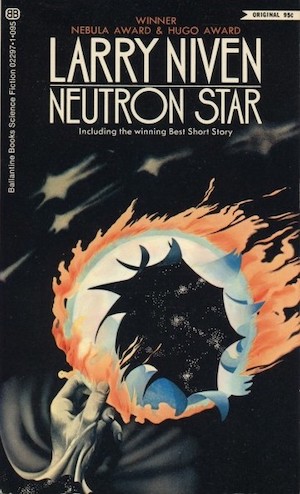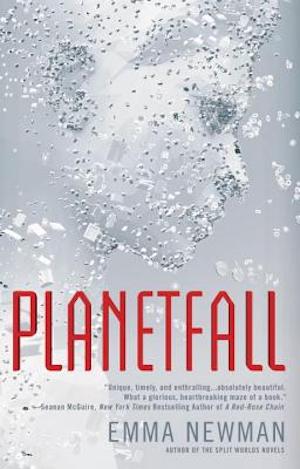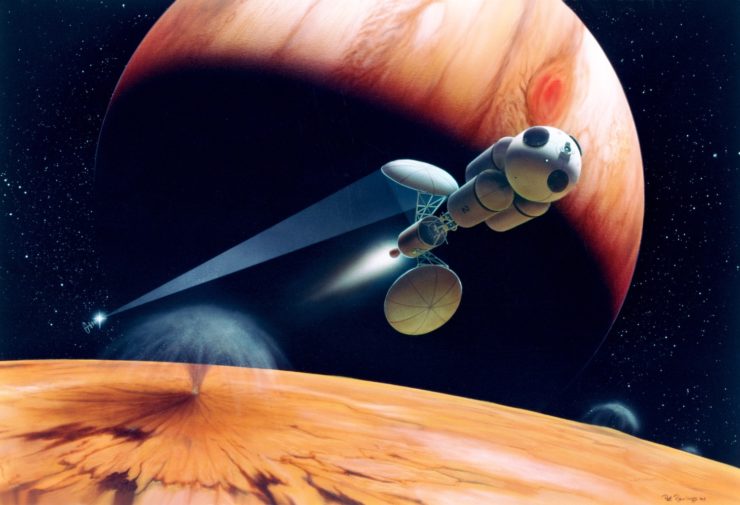Given our recent discussion of such tales, I should note that I quite dislike one particular subset of lifeboat stories: the ones in which a small group of plucky pioneers somehow escape the dying Earth and reach a new world they can call their own. But in the meantime, the unlucky masses who could not make their way onto the flotilla die with their homeworld.
Why this distaste? Well…
(1) I don’t like it when protagonists win prizes by cashing in tokens consisting of other people’s lives. It seems that some authors are happy to kill off most of humanity as long there’s interstellar colonization. Perhaps getting rid of most of the population is the point? Jo Walton would describe this as a cosy catastrophe. Finally, an end to all those other people while the virtuous get a brand-new world.
(2) A successful escape is unlikely. A planet on the verge of destruction will have a hard time building a functional interplanetary or interstellar lifeboat with enough capacity to deliver a viable community to the target. Particularly when doing so in double-quick time. Even more so if it’s a small group doing the planning and construction.1 If the problem is simple enough that a handful of people could pull it off, odds are a lot of handfuls would manage it.
(3) If we’re talking stories limited to the Solar System, there are no backup Earths. A post-dinosaur-killing impact Earth is still more habitable than anything else available locally. Even nuclear war would have a hard time making the Earth as hostile as any other world in the Solar System.2
Firefly’s backstory provides a marvelous example of the sort of thing I don’t ever want to see again: The Earth was somehow used up, despite which an astonishingly homogeneous subset of humanity managed to make it to another star system armed with the exact sort of terraforming technology that should have made repairing Earth easy-peasy.
Still, I have enjoyed some novels that subvert the trope.

Take, for example, Joan Slonczewski’s 1980 Still Forms on Foxfield. A UN report predicting the near-certainty of nuclear war spurred a golden age of space colonization R&D. Twenty years later, atomic war having failed to materialize, the product of that R&D was available for a group of Quakers to purchase as surplus. Imagine their surprise when they reached their destination to hear only ominous silence from the Solar System. Apparently, that UN report was correct after all, and Earth has perished in fire. Except, as we learn at the beginning of the novel, that is not quite correct either. Foxfield’s colonists, isolated for generations, must deal with sudden and unexpected contact from a world they assumed dead.
***

Although it is merely a background detail in Stephen Baxter’s 2000 The Light of Other Days, characters accept as inevitable that the giant asteroid Wormwood would in five centuries’ time obliterate life on Earth. As it turns out, five centuries is a long time and challenges that appear intractable at the beginning may not be by the end. After all, it is a problem that everyone on Earth is highly motivated to solve.
***

For that matter, the discovery in Larry Niven’s 1966 “At the Core” presents the usual set-up on a much vaster scale. The core of the Milky Way has exploded! Doom is utterly assured! On a timescale far beyond the human temporal horizon! While more prudent species fire up their intergalactic transport solutions, humanity leaves the problem to their many-times grandkids to solve. If there’s one thing humans are good at, it’s kidding themselves that inevitable consequences are not, even now, barrelling their way. Just ask me about climate change!
***

Emma Newman’s Planetfall series—Planetfall (2015), After Atlas (2016), Before Mars (2018) and Atlas Alone (2019)—provides a particularly ominous and plausible explanation as to how a small handful of survivors might somehow escape their world immediately before doomsday. They could set off doomsday once they embarked; this would prevent those nasty others from following the colonists to their promised land.
***
Perhaps you have your own favourite subversions of this popular trope? The comments are, as ever, below.
In the words of Wikipedia editor TexasAndroid, prolific book reviewer and perennial Darwin Award nominee James Davis Nicoll is of “questionable notability.” His work has appeared in Publishers Weekly and Romantic Times as well as on his own websites, James Nicoll Reviews and Young People Read Old SFF(where he is assisted by editor Karen Lofstrom and web person Adrienne L. Travis). He is a four-time finalist for the Best Fan Writer Hugo Award and is surprisingly flammable.
[1]Ah, you ask, what if it’s the whole world pitching in and all they can manage is the one fleet? Well, unless doomsday is very fine-tuned, it’s going to be hard to avoid either not quite launching the fleet in time or developing enough capacity for more than one effort. Most importantly, this line of thinking could lead to a remake of 1973’s “The Starlost.”
[2]Thomas N. Scortia’s 1974 “Earthwreck!” got around this with a three-fold solution. Firstly, new probes conveniently revealed that Mars was much less hostile than had been believed—although it was still very much a fixer-upper. Secondly, because the protagonists were on U.S. and Soviet space stations, they already had the means to go to Mars on hand, provided they cooperated. Thirdly, even after World War Three, Earth still would have been a better bet than Mars except that one of the weapons used was a particularly virulent bioweapon that might infiltrate any sealed habitats on Earth. In Edmund Cooper’s 1973 “The Tenth Planet” (emphatically not recommended), the colonists picked their incredibly hostile home world because the community’s founder believed that a natural world continually trying to kill them would distract humans from thinking up reasons to kill each other.










